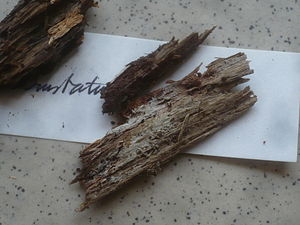Hyphoderma incrustatum
| Hyphoderma incrustatum | ||||||||||||
|---|---|---|---|---|---|---|---|---|---|---|---|---|

Hyphoderma incrustatum |
||||||||||||
| Systematics | ||||||||||||
|
||||||||||||
| Scientific name | ||||||||||||
| Hyphoderma incrustatum | ||||||||||||
| Larsson |
Hyphoderma incrustatum is a mushroom species from the family of the fold relatives (Meruliaceae). It has carpet-like, membranous fruiting bodies of whitish color and grows on dead wood of bedecktsamern . The species is probably distributed in the Holarctic .
features
Macroscopic features
Hyphoderma incrustatum has resupinate, membranous-waxy fruiting bodies typical of the genus Hyphoderma . They are whitish to cream in color. Their hymenium is smooth under the naked eye (but more or less porous under the magnifying glass), the edge is not clearly contoured.
Microscopic features
As with all Hyphoderma species, the hyphae structure of Hyphoderma incrustatum is monomitic, i.e. it shows exclusively generative hyphae . There are incrustations on all structures of the hymenium and on all hyphae. The 3–5 µm wide hyphae are hyaline and thin-walled, the septa always have buckles . The species has two different types of cystidia : Some are tubular, thin-walled and with 50–80 × 6–10 µm protrude only slightly above the fruit layer. The others are slightly head-shaped, widened at the base, constricted under the tip and around 20–40 × 5–7 µm in size. The basidia of the species are club-shaped to approximately urn-shaped, heavily encrusted and waisted in the middle. They have four sterigmata and measure 25–35 × 6–8 µm. They have a buckle at the base . Their spores are cylindrical, hyaline, and thin-walled. They measure 11–14 × 4–5 µm and have a large drop of oil in the protoplasm .
distribution
The known distribution of the species probably covers a Holarctic area. The distribution in Europe includes regions of the temperate climate zone.
ecology
Hyphoderma incrustatum grows on dead wood of flowering seeds . Unlike the closely related Hyphoderma nemorale , it is preferably found on larger, already strongly rotten pieces of wood. It prefers moist forest habitats.
literature
- Annarosa Bernicchia, SP Gorjón: Fungi Europaei. Volume 12: Corticiaceae sl Edizioni Candusso, Alassio 2010. ISBN 978-88-901057-9-1 .